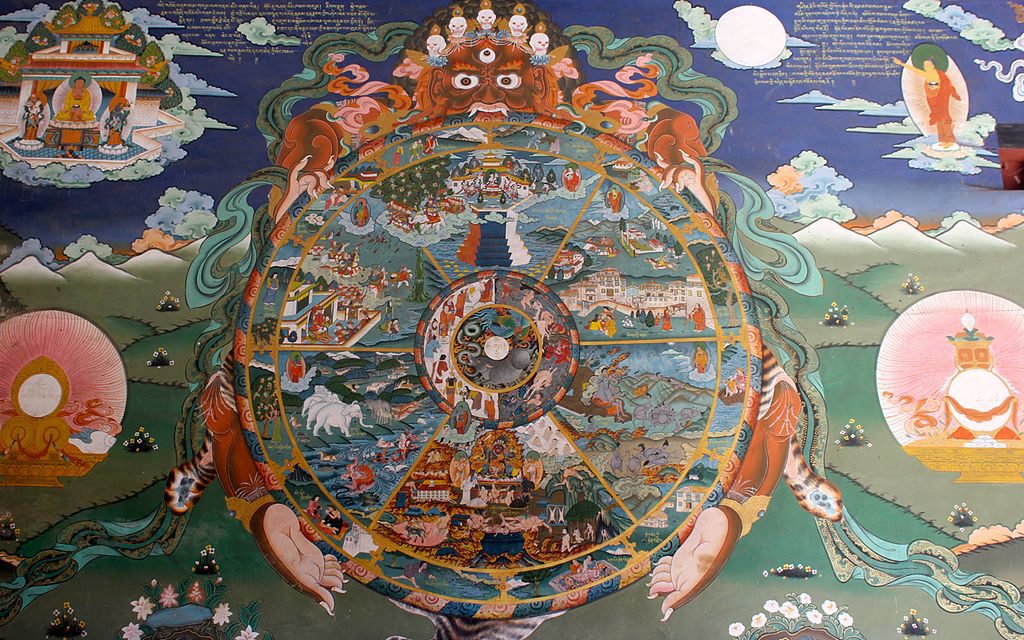Right Mindfulness is the part of the Eightfold Path of Buddhism, which means it is an essential part of Buddhist practice. Mindfulness is a whole-body-and-mind awareness of the present moment. To be mindful is to be fully present, not lost in daydreams, anticipation or worry.
The Buddhist practice of mindfulness has four foundations: Mindfulness of body (in Pali, kayasati), of feelings or sensations (vedanasati), of mental states (cittasati), and of mental objects or qualities (dhammasati). This article will look at the fourth foundation.
A literal translation of the Pali word dhammasati is “mindfulness (sati) of dhamma (or, in Sanskrit, dharma).” To understand this foundation, we need to begin with a look at dharma.
Dharma is a Sanskrit word that is used to mean a lot of different things. In its broadest sense it means something like “natural law.” In Buddhism, it is often used to mean “teaching of the Buddha.” It also can refer to the nature of existence or to phenomena as manifestations of reality, and these last two meanings are closest to the dhamma of dhammasati.
See “What Is Dharma in Buddhism?” for a more detailed explanation of dharma.
Expanding Our Awareness
The four foundations describe a process that begins, traditionally, with mindfulness of the breath. From there one practices mindfulness of the body, of sensations and emotions, and of mental states.
This practice is a whole-body-and-mind experience without conceptualization. In other words, mindfulness is being fully aware and present with the body or with feelings. It is not “thinking about” these frames of reference or concocting ideas about them. Further, there is not “my” body or feelings; there is just body or feelings.
The foundations are frames of reference for mindfulness — body, feelings, mind. But mindfulness of dharma suggests an awareness of everything. How do we do that?
Many teachers explain this foundation as a mindfulness of phenomena. Put another way, it is mindfulness of the experience of the phenomenal world.
The Tibetan Buddhist teacher Dzogchen Ponlop Rinpoche explained the fourth foundation as “basically the recognition of the interdependent relationship of our mind and the phenomenal world. It is working with the relationship of each individual phenomenon existing around us as the object of our experience.” What does that mean?
Me and Everything Else?
It’s important to understand that the “phenomenal world” is not something that is “out there,” separate from us. The Buddha taught that everything inter-exists. All phenomena, including us, are conditioned and defined by all other phenomena. This is because that is.
Individual things — from teapots and toasters to living beings — are experienced as mental objects. We “know” them as we know them because of how our brains and senses respond to stimuli and also because we’ve been taught from birth to recognize things in a particular way. This is the interdependent relationship of the mind and the phenomenal world.
Very basically, mindfulness of dharmas is a pure awareness of whatever there is. If there is birdsong, there is birdsong. It is not you listening to birdsong. Nor is the birdsong coming from “out there” somewhere. The experience of birdsong is right here.
The Wheel of Samsara
In the Satipatthana Sutta of the Pali Tipitika (Majjhima Nikaya 10), the Buddha begins his teaching on the fourth foundation by advising his disciples to be mindful of the Five Hindrances. Naming each of the five — sensual desire, ill will, sloth, resltnessness, and uncertainty — he counseled being aware of whether the hindrance is present, and if present how it arises, and how it ceases.
Then the Buddha spoke of the Five Skandhas, calling them the “aggregates of clinging.” He advised his disciples to be aware of the skandhas and the corresponding senses organs and objects. The monks and nuns also were taught to contemplate the factors of enlightenment and the Four Noble Truths.
Many Buddhist teachers advocate mindfulness of what binds us to samsara. In particular, be aware of the twelve links of dependent origination.
The Vietnamese Buddhist teacher Thich Nhat Hanh says that Right Mindfulness is at the heart of the Buddha’s teaching. “When Right Mindfulness is present, the Four Noble Truths and the other seven elements of the Eightfold Path are also present” (The Heart of the Buddha’s Teaching, p. 59). This is particularly true of the mindfulness of dharma.
Wisdom
In Mahayana Buddhism, the fourth foundation of mindfulness is awareness of sunyata, or emptiness, which is also the basis of wisdom. This much-misunderstood doctrine teaches us that all phenomena are empty of self-essence as well as inter-existing. The distinction we see between this and that is something we are projecting; it is not intrinsic to the things and beings around us. So, in a sense, a particular phenomenon exists as a mental object, not as a thing-in-itself. See also the Two Truths.
[This is an article I wrote for the Buddhism section of About.com. However, since About.com has removed it from their servers, all rights revert to me.]

